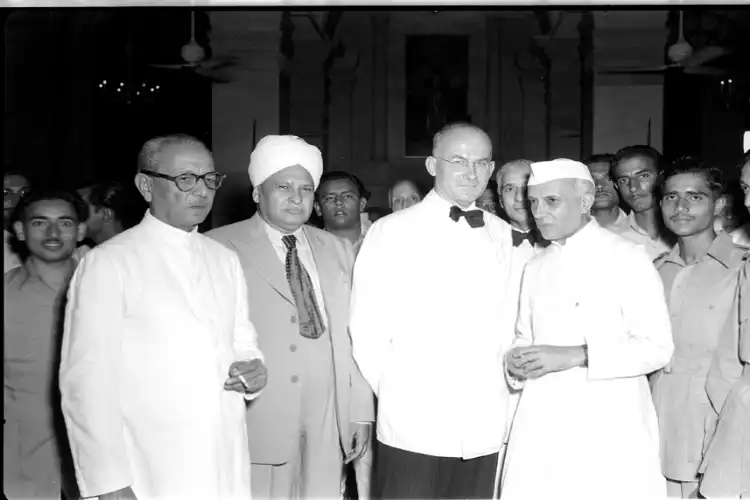Asaf Ali (Extreme left) as Governor of Orissa (Now Odhisa) nwith Prime Minister Jawahar Lal Nehru and others
Saquib Salim
Asaf Ali has several possible introductions. He is best known for arguing the cases of Bhagat Singh and Batukeshwar Dutt, soldiers of Azad Hind Fauj, Railways Minister, who ended the religious segregation of water vessels, and the first Indian Ambassador to the USA. But, one aspect of this great son of the soil that is often overlooked was his association with Veer Savarkar and other India House revolutionaries in London.
In 1909, When Asaf was traveling to London for higher education a well-known nationalist leader, Syed Haider Raza, was with him. Raza had already made a name for himself as one of the leaders of agitations in Punjab led by Sardar Ajit Singh and Lala Lajpat Rai. Raza was being funded by Shyamji Krishan Verma, who had already called Veer Savarkar with a similar fellowship in 1906. Raza would go on to become an important member of the group headed by Savarkar.
Asaf had his first brush with radical revolutionary politics in Paris, where they halted on the way to London. He met Shyamji Krishan Verma, a father figure of Indian revolutionaries, who were funding nationalists to study in English universities. Verma ensured that his first stay in London would be at India House, a lodging where Indian students funded by Verma used to study. It was this Indian House where Savarkar lived and revolutionaries met every week to discuss political developments.
Asaf later recalled, “I wonder how so young a person (Savarkar in 1909) commanded the will of almost everyone who came into contact with him...nor is it an exaggeration to say that Savarkar is one of the few effective speakers I have known and heard, and there is hardly an orator of the first rank either here or in England whom I have not had the privilege of hearing.” India House at that time was frequented by revolutionaries like Bipin Chandra Pal, Niranjan Pal, Dr. K. P Jaiswal, W. V. Phadke, Sikandar Hayat, Saklatwala, Virendranath Chattopadhyay and several others like Madan Lal Dhingra stayed there. All of them met on Sundays and Savarkar owing to his oratory skills was considered a leader.
Asaf wrote, “Savarkar was the presiding deity of India House and was already well entrenched”. He recalled further, “Savarkar…despite his careless English, had so genuine a ring of sincerity in his speech that he almost always made a memorable impact on the audience.”
Asaf in his writings recalled Dussehra of 1909 organized by the India House people where Mahatma Gandhi was invited as a guest. He wrote, “A notable event was the Dussehra dinner organised in August 1909 at Nizamuddin’s Indian restaurant at Bayswater, where the guest of honour was Mr. (not yet Mahatma) Gandhi, hero of the civil resistance campaign by Indians in South Africa. He had come to London to present the ease of the Indian settlers before the British government. But his speech was very brief - just a dozen sentences or so-and tepidly moderate. He concluded abruptly with the words, ‘I should not like to stand between you and the speaker of the evening, Mr. Savarkar.’ Dazzlingly brilliant was Savarkar’s speech that evening. His theme was the struggle between Rama and Ravana, between righteousness and unrighteousness. He compared it dexterously with its modern counterpart, the struggle of subject India against British rule.”
Asaf remained in close contact with Savarkar and his group till the latter’s arrest after Madan Lal Dhingra assassinated Curzon. About the meetings at India House and Savarkar, he wrote, “Sometimes readings were given out of Savarkar’s history of the War of Independence. He had turned his opportunities to work in the India Office library to good account by collecting the material for his survey of the events of 1857 from the Indian point of view.”
In the last meeting at India House before Dhingra assassinated Curzon, Asaf presided over the Sunday meeting. Asaf remembered Dhingra’s last meeting as, “That day he (Dhingra) was in a strange mood, and looked hungry for something. I thought that he was feeling nostalgic. As Nanu’s Bengali song, for which I stayed on, did not satisfy Dhingra’s longing for an Urdu song, he turned to me with his request. I went to the organ, and sang and played an Urdu Ghazal and a Thumri. He went into a transport of joy, which seemed to me rather extravagant.”
Little did Asaf know that Dhingra was going to embrace martyrdom by killing Sir Curzon Wyllie three days later. Savarkar was soon caught and sent to the Andamans.
Asaf later, in 1948, lamented, “how the wheel of destiny has turned in the opposite direction today! After Mahatma Gandhi's assassination, Savarkar's house was raided by an angry mob, and the police rescued and guarded him. The irate mob appeared to have suspected him of some connection with Mahatmaji's assassin.”
This aspect of Asaf Ali remains on the margins of our history books because it does not help any major political narrative. But, it helps the narrative of India, where people of every religion, ideology, region, colour, and language fight for the honour of the motherland.

